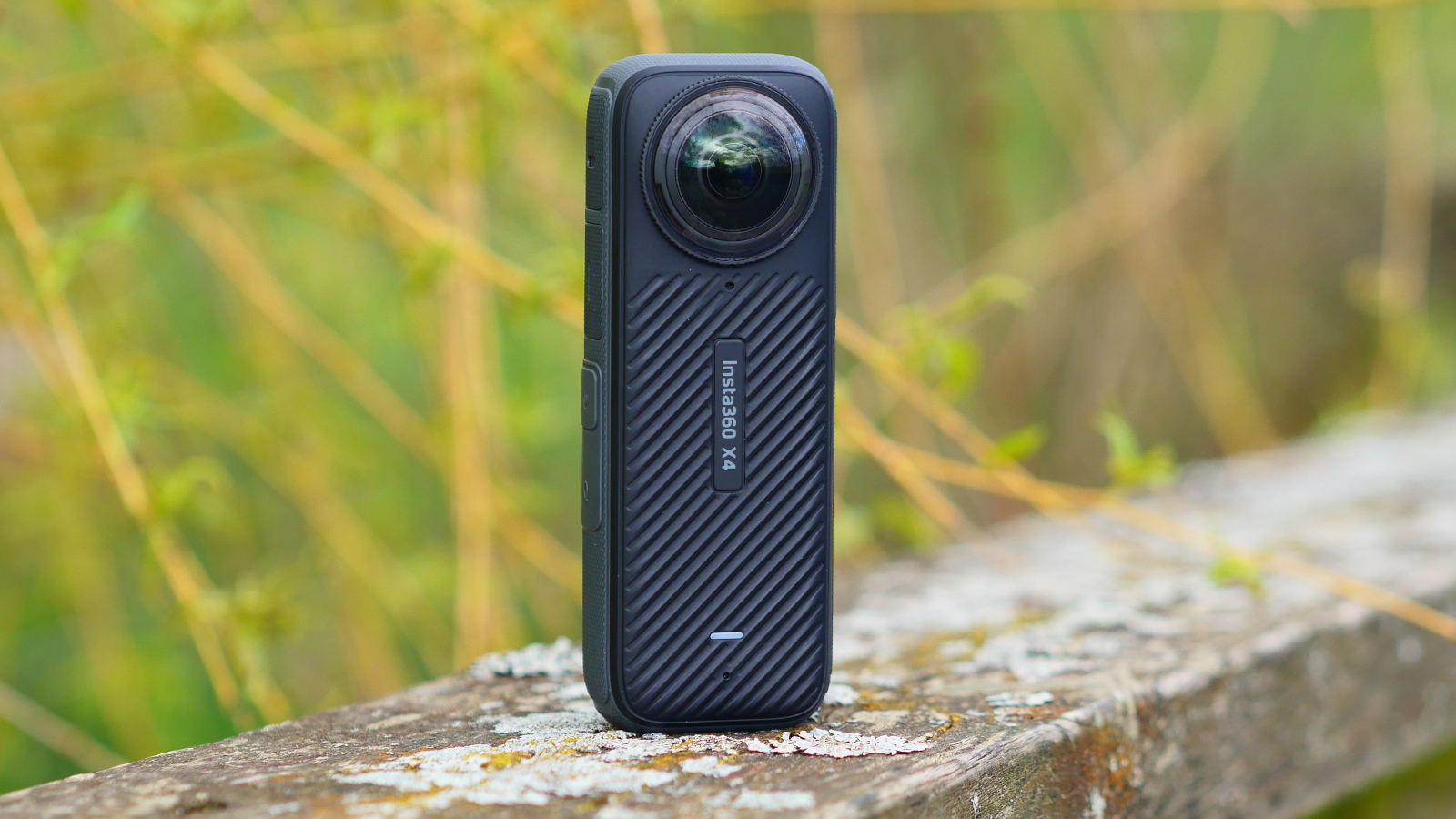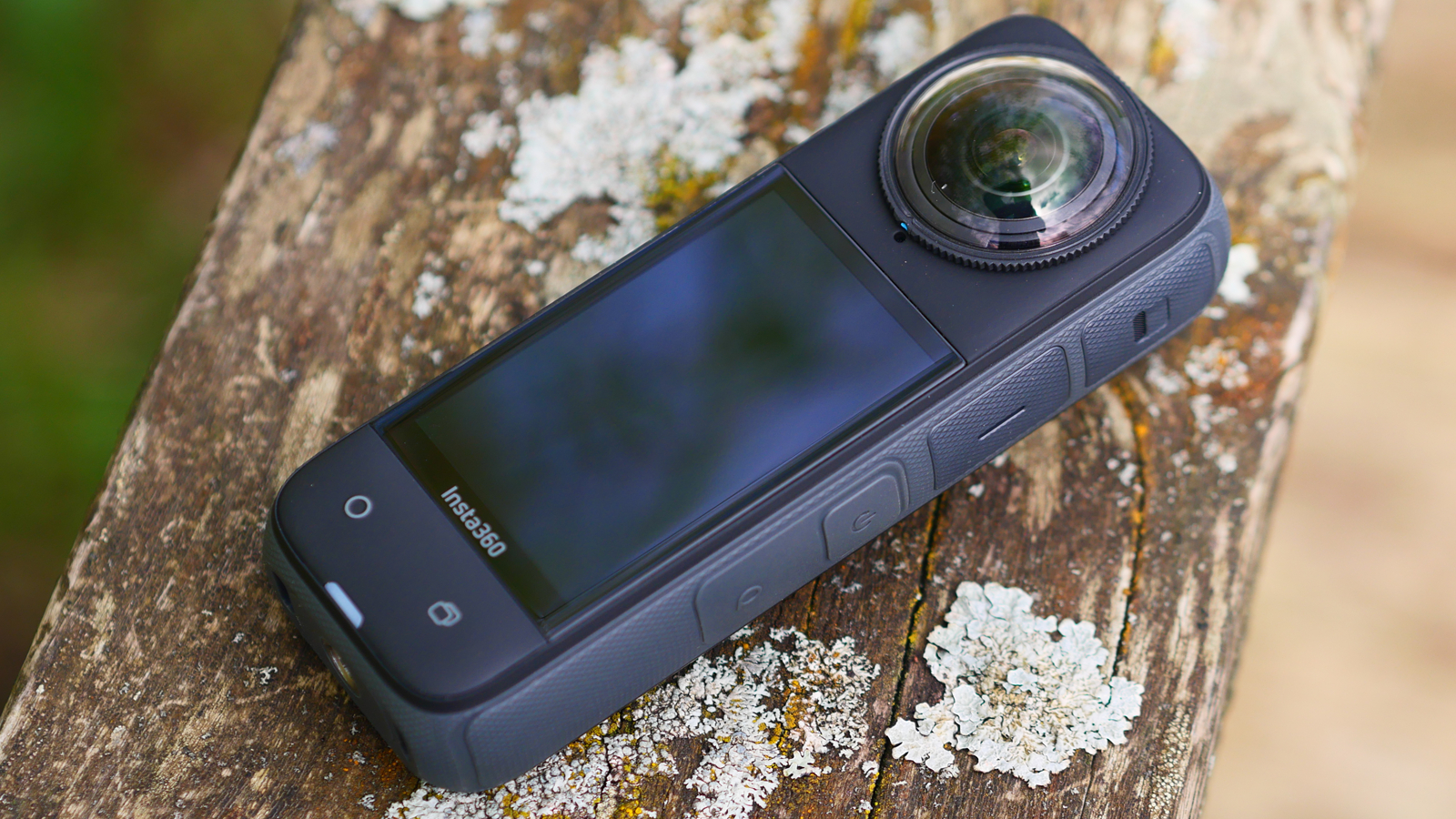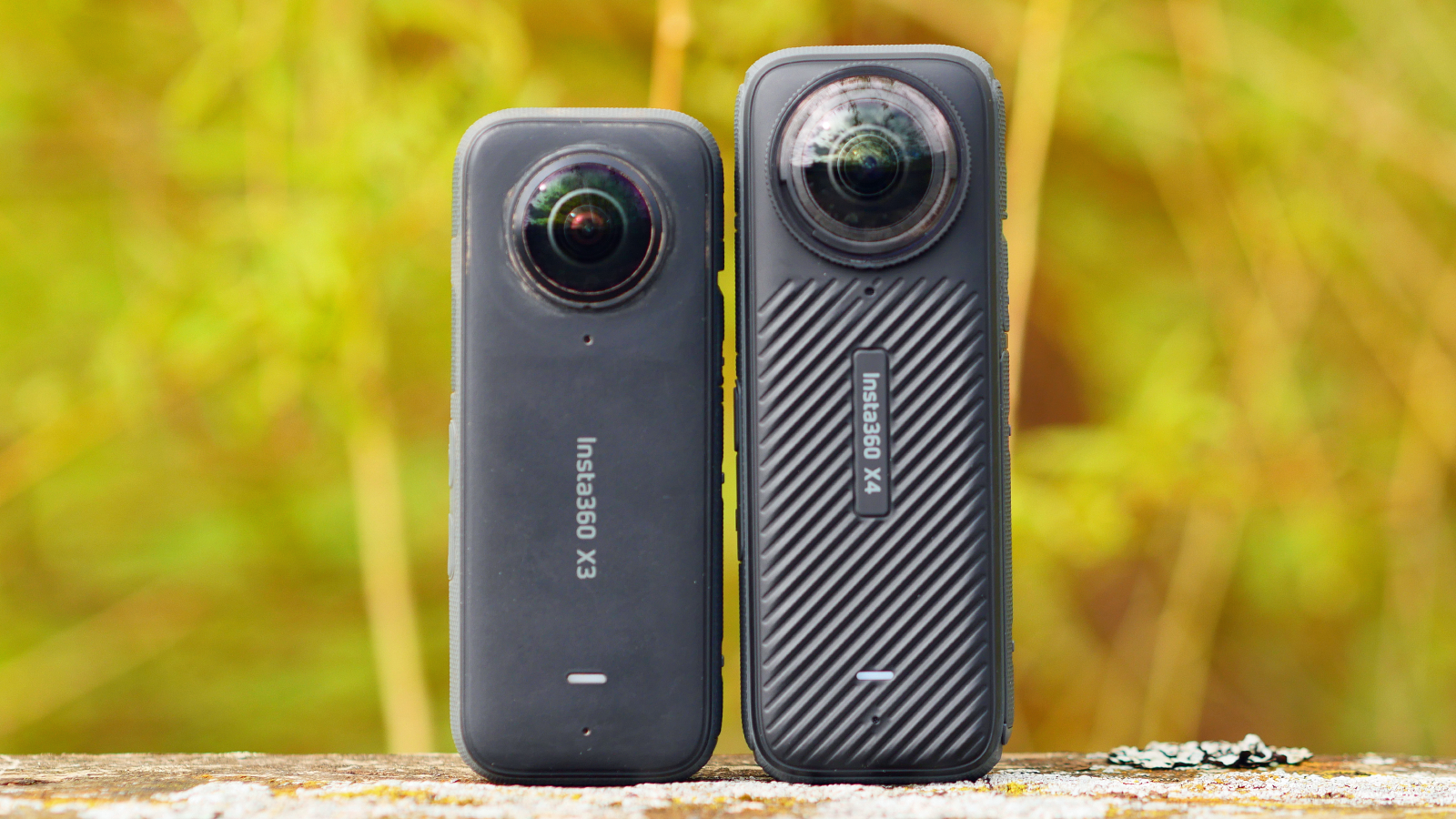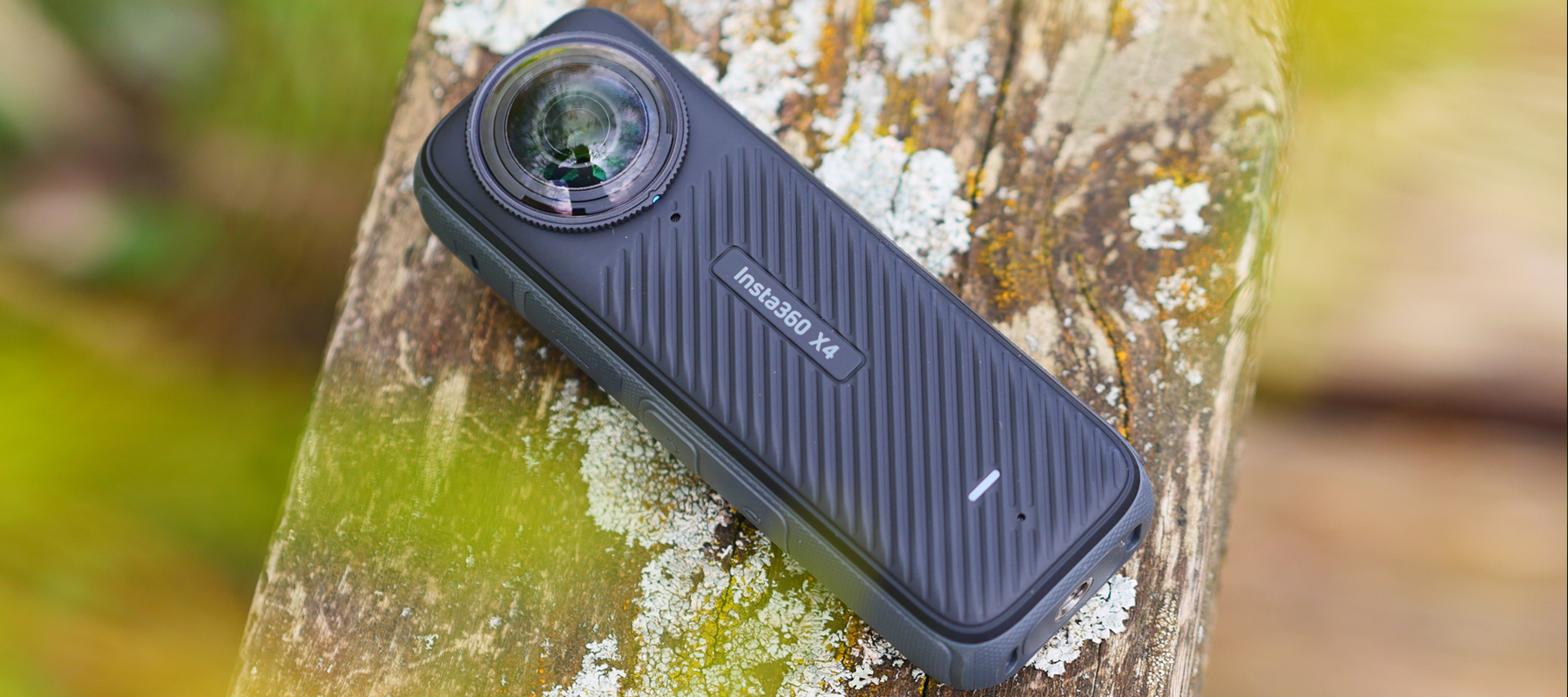Early Verdict
The X4 builds on the successes of the X3, although upgrades in performance don't come without their downsides.
Pros
- +
Now shoots 8K 360-degree footage
- +
Longer battery life
- +
Faster start-up
- +
Customizable Quick Capture mode
- +
Easy navigation and menus
- +
360 reframing and angles give lots of options when editing
- +
Lens covers included in box
Cons
- -
Larger and heavier
- -
Threaded mount requires additional accessories for traditional action camera mounts
- -
Lens covers fill with water when submerged
- -
Quarter-inch thread to action camera adapter not included
Why trust BikePerfect
Insta360 has launched its latest 360-degree action camera, the X4. The new camera gets a bump in video specs, battery life, and screen size shapes up to make the Insta360 X4 the best MTB action camera on the market if you're looking to record 360-degree footage.
The X4 has a tough act to follow though, the popular Insta360 X3 has been a hit since its release back in 2022 when it quickly established itself as one of the best 360-degree capable action cameras. While the X3 doesn’t have the power and performance of the new X4, its smaller size, lower weight, and more palatable price point mean choosing between the cameras is a little less straightforward for riders looking for a 360 action camera.

Design and specifications
The 1/2in sensor of the X4 is the same size as the X3 but can now deliver 8K 360-degree footage at 30fps (frames per second). The 5.7k 360 footage also gets a bump and is now capable of 60fps. The video max bitrate has also been upped from 120Mbps to 200Mbps. The Timelapse mode can now shoot in 11K and you can still capture 72mp 360-degree pictures.
It's not just the 360 imaging that gets an upgrade, the single lens performance has also been improved with increased framerate and features. The X4 can now shoot in 4K at 60fps, while that's not going to worry GoPro’s Hero 12 with its 5.3K, there is more to POV footage than megapixels. The GoPro’s 157-degree field of view (FOV) sounds wide, but the X4 can now shoot in MaxView at an upgraded 4K30fps with a massive 170-degree field of view so you will capture everything the camera is pointed at. There is also a new MegaView FOV option available in the app/Studio which is roughly as wide as the existing UltraWide setting but has less distortion.
The ISO range sees a small increase and now maxes out at 6400 which should help improve video quality in low-light situations, although the auto ISO setting can only be set at a max of 3200.
There don't appear to be any updates to Insta360’s already impressive FlowState Stabilization and 360-degree horizon lock Stabilization. Although if there is a boost in low-light performance, it should help the stabilization perform better in dense tree cover.
One of the weak areas of the X3, and every other action camera that has ever existed, is audio quality in windy conditions. Alongside the Stereo mode and Direction Focus settings, Insta360 X3 also had Auto Wind Noise Reduction – although from my experience it wasn’t all that effective. The X4 sees a new Active Wind Reduction mode added which is said to be designed for “fast paced action such as motorcycles and skiing”, hopefully this includes mountain biking too.

Although the two cameras visually look almost the same bar the new textured surface, there are several subtle and not-so-subtle differences. To start with, in hand, the X4 is a noticeably bigger camera measuring 123mm x 46mm x 37.6mm compared to the 114mm x 46mm x 33.1mm of the X3. Weight is also up with the X4 weighing in at 204g on our scales, 24g heavier than the X3. Presumably, the bigger form is to fit the tech needed for 8K recording, processing, and battery power. The bigger form also means the touch screen is now larger at 2.5in. The screen is now made of Gorilla glass to help protect from the rough and tumble of outdoor sports.
The battery in the X4 is significantly bigger too, with 2290mAh compared to the 1800mAh of the previous camera. While I haven't put it to the test yet, Insta360 claims the X4 ran 67 percent longer, recording for 135 minutes at 5.7K 30fps or 75 minutes at 8K 30fps in a lab environment. Charging the battery to 100 percent is said to take just 55 minutes (9V 2A), but if you can't wait, it will reach 80 percent in 38 minutes.
The general layout hasn’t changed. Looking at the screen the right-hand side features the power button a quick menu button which allows access to customizable recording profiles. On the left side the memory card, battery, and USB-C plug are housed behind doors that securely clip closed. Like the X3, the X4 has four-way audio recording although the microphone holes on the sides are considerably larger and the screen side microphone is now positioned under the lens.
To attach the camera to selfie sticks, tripods, and human beings, there’s a standard quarter-inch threaded mount on the bottom. The X4 doesn't come with a threaded-to-action camera mount adapter so you will need to buy the adapter if you want to mount the X4 to a standard chesty or helmet.
The X4 is waterproof and rated to a depth of 10m, for proper underwater shooting there is an Invisible Dive Case for shooting down to 50m.

The X4 comes with a new removable lens guard in the box, or there's a premium removable lens guard available separately, which neatly screws onto the front and rear of the X4. For those who often ride in filthy conditions, it will be a welcome addition to help avoid scratches to the lens without resorting to physically sticking something to your camera, although placing any product over the lens of a camera will affect the image quality.
It's not just the camera that gets some upgrades, Insta360 has updated its supporting software too. Downloading clips should be faster now, an upgrade to USB-C 3.0 improves data transfer to a computer plus wireless transfer speeds are claimed to have increased by 58 percent compared to the X3 so you can get your POV bangers up on the ‘gram even faster. On mobile, using the Quick connection (iOS only) feature means transferring clips to your phone is just a case of hitting download on the camera and accepting the connection on your phone, rather than manually connecting to the camera with WiFi first. One of our biggest gripes with the mobile app was the max export quality of 1080p, which significantly throttled the usefulness of the app. This has been increased slightly to 1440p and exports can be run in the background which is a nice touch. On the computer, the 360 files are also now saved in a single .INSV file, rather than as two files, which should help simplify workflow and archiving of footage.
Footage can still be edited on desktop or mobile devices, reframing can be performed using Quick Edit (formerly known as Snap Wizard) which involves moving your phone to reframe a clip, keyframes, or a new Ai Edit (previously the "Auto" option) which uses an algorithm to handle the entire reframing process.
Insta360 has an Insta360 Reframe plugin for Adobe Premiere Pro which could speed up the editing process by allowing 360 shots to be reframed directly in Premiere Pro. You can also import overlaying data like GPS, speed, and power from your Garmin device or Apple Watch to create real-time stats dashboards embedded in your footage.

Performance
Although I haven’t had time to take the Insta360 X4 out on the trails yet, I have set it up and had a little time to play with it.
Menus and navigation follow much the same format as the X3, which are generally intuitive and easy to navigate via on-screen buttons and swipes. The X4 has a few more features though so there are a couple of differences however they are easy enough to figure out. There are some improvements too, for example, shooting settings are now shown on the capture screen so you don’t need to go back into the menu to check before you start shooting.
One bugbear of the X3 was the poorly considered Quick Capture feature. Being able to press the capture button and record a clip while riding is very handy for quickly recording some action. The X3 used a default 360 5.7K30fps with Auto exposure settings and often produced sub-par POV results. This has been updated on the X4 and you can now easily set up your own personalized Quick Capture settings to ensure you have the right settings for the environment..
The X4 is noticeably faster in operation too, our X4 camera powered on in around 4 seconds which is about twice as fast as the X3, Quick Capture is around the same too. Saving a clip is also quicker and general navigation is noticeably more fluid as well.
I'm a little disappointed that the Insta360 X4 has grown in size, the X3 was already an unpractical shape for chesty or helmet mounting, and increasing the size and weight of the X4 is only going to compound this. Extra leverage caused by the added weight and length means you will need a very secure chesty or helmet mount to keep it secure and stable. The larger form does mean there is space for a bigger screen and battery, however, ease of mounting is an extremely important consideration for a MTB action camera. This could be a deal breaker for many riders, pushing POV-focused creators to return to traditional action cameras like Insta360’s new Ace, mainstay GoPro Hero 12 or even the ultra-compact Insta360 Go 3.

Old butter fingers here put the X4 through an impromptu shock and waterproofing test when I dropped the X4 into a pond when shooting the pictures for this first look. The good news is the camera came away completely unscathed from both the freefall onto a wooden bridge and the five minutes it spent submerged in the pond before I could scoop it back out. One thing I did notice was a lot of water collected behind the lens guard. While I don’t expect this to be an issue when riding, it would be something to keep in mind if you are dipping the X4 underwater for a shot.
I won’t comment too much on video quality until I have recorded some actual footage on the bike. But based on a few clips recorded from my dingy desk comparing the X3 and X4, the X4 appears to produce a sharper, cleaner image. The X4 also appears to handle low light considerably better, with more details in both shadow and highlights which is promising for trail riding under heavy tree cover.

Verdict
The X4 is an evolution of the already great X3 with Insta360 focusing on filling the gaps and making it a more rounded camera. 8K should be a dramatic improvement in 360 quality although this probably appeals more to the cinematographer than the casual mountain biking content creator. Although they are more minor, the advancements in the single lens capture and Me Mode will appeal to MTB POV vlogger types and, assuming you’re happy to deal with the larger, heavier, and kinda awkward form factor, the X4 could potentially be a win for video diaries and POV clip stackers.
Another area that won't appeal will be the $50 / £50 price hike. That said if you are looking for an up-to-date 360 and POV capable camera, at $499.99 / £499.99 / €559.99 the Insta360 X4 appears to be a better buy than the now-aged GoPro Max ($499.99 / £479.99) released back in 2019 or Insta360’s own modular One RS.
I will put the camera to a proper trail test over the coming weeks so stay tuned for a full review and sample footage soon.
Tech specs: Insta360 X4 action camera
- Price: $499.99 / £499.99 / €559.99
- Aperture: f/1.9
- 35mm Equivalent Focal Length: 6.7mm
- Photo Resolution: 72MP (11968x5984), 18MP (5952x2976)
- 360 Video Resolution: 8K (7680x3840@30/25/24fps), 5.7K+ (5760x2880@30/25/24fps), 5.7K (5760x2880@60/50/30/25/24fps), 4K (3840x1920@100/60/50/30/25/24fps)
- Single-Lens Video Resolution: 4K (3840x2160@60/50/30/25/24fps), 2.7K (2720x1536@60/50/30/25/24fps), 1080p (1920x1080@60/50/30/25/24fps)
- Photo Format: insp, RAW (DNG) (RAW files require software on PC/Mac to export.)
- Video Format: Single-Lens Mode: MP4, 360: INSV
- Photo Modes: Standard, HDR, Burst, Interval, Starlapse
- Video Modes: Standard, Active HDR, Timelapse, TimeShift, Bullet Time, Loop Recording
- Color Profiles: Standard, Vivid, LOG
- Run Time: 81 Minutes (5.7K@30fps mode)
- Max. Video Bitrate: 200Mbps
- ISO Range: 100-6400
- Shutter Speed: Photo: 1/8000 – 120s, Video: 1/8000 – to the limit of frames per second
- Audio format: 48 kHz, 16bits, AAC
- Dimensions: 46x123.6x37.6mm
- Weight: 204g

Graham Cottingham joined the BikePerfect team as our senior tech writer in 2020. With over 20 years of riding experience, he has dabbled in downhill, enduro, and gravel racing. Not afraid of a challenge, Graham has embraced bikepacking over the last few years and likes nothing more than strapping some bags to his bike and covering big miles to explore Scotland's wildernesses. When he isn’t shredding the gnar in the Tweed Valley, sleeping in bushes, or tinkering with bikes, he is writing tech reviews for BikePerfect.
Rides: Cotic SolarisMax, Stooge MK4, 24 Bicycles Le Toy 3, Surly Steamroller
Height: 177cm
Weight: 71kg

